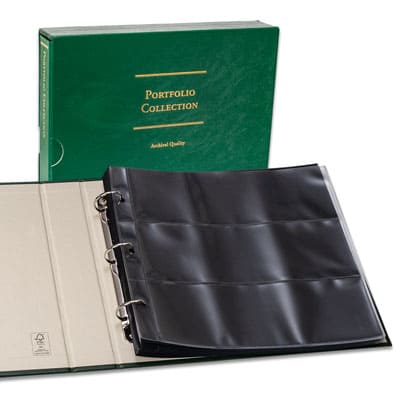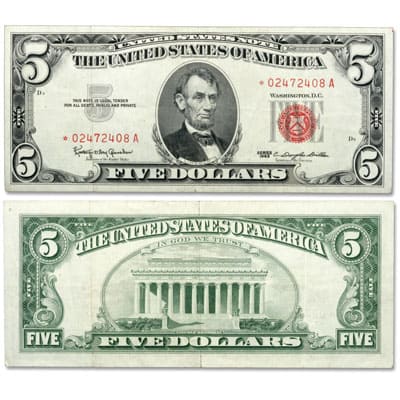Move over, error coins…Star notes are highly collectible, too!
Every coin collector knows discovering a double-punch, a missing mint mark, or even an extra tail feather is the thrill of finding an error coin.
But did you know paper money collectors experience a similar excitement when they come across a star note?

I did a few weeks ago. Coincidentally, it was the same week I was writing about star notes for our summer Showcase catalog. Counting the fresh, crisp bills the bank teller had given me as part of my withdrawal, I let out a tiny squeal of recognition!
Two Series 2017 $1 Federal Reserve Bank of New York star notes, in sequence. I kept them flat in the bank envelope on the dashboard. Once home, I transferred them to a new sheet in my small-size currency portfolio.
Star notes’ start
The U.S. Bureau of Engraving and Printing (BEP) uses star notes to replace currency where an error has been found just before it goes into circulation. The star with the hollow center is actually an asterisk designed to draw attention to the note’s status as a replacement, along with a one-digit change to the serial number. The serial number of the imperfect note is not used again in the same numbering sequence.
“Star notes are very popular and there many ways to collect these replacement notes to fit your overall goal and budget,” said Ken Westover, a Littleton Coin Company buyer who specializes in paper money. “You can choose to have a small representative set of the major design types.
“Or, you can acquire as many different types and denomination as possible. There really is no wrong way to collect them.”
BEP found it easier to institute star notes around 1910 when new printing presses made it more cost-effective to print sheets of corrected bank notes. You can find out more about how paper money is printed at Littleton Coin’s Learn Center.
Getting Inked
Star note collectors also have a rainbow of ink colors to look for when they’re putting together an album. Green ink is applied to the serial numbers, stars, plus the Treasury Seal found on federal reserve notes used today. But, when talking about these replacement bank notes, the correct word order and proper name is Green Seal Federal Reserve Star Note.
The same order holds true for the Red Seal Legal Tender Star Note and the Blue Seal Silver Certificate Star Note. Harder to find are Gold Certificate Star Notes and the Brown Seal Federal Reserve Bank Note Star Notes.
“Like most numismatic items, condition and rarity of a particular design are key factors in determining a note’s value,” Ken continued. “The more significant rarities are usually a combination of both of these factors.
“While those notes that are more readily available may only have modest differences in value from circulated grades to uncirculated grades.”
Then I looked up mine
To better appreciate the unexpected my unexpected find of star notes in my bank withdrawal, I went to the BEP website and its resources page. My Series 2017 federal reserve star notes from the Federal Reserve Bank of New York were printed in Washington, D.C. during May 2018…and were two of 3.2 million $1 star notes printed.
Sigh.
I rationalized my research with a little poetic license from Alfred Lord Tennyson that it’s better to have found two star notes than never to have found any at all.
“Rule of thumb for new currency collectors,” Ken advised me, “is to always check your bills. And, not just from the bank.”
New and noteworthy
But future, faster discoveries are right around the corner! Littleton Coin Company has a few noteworthy replacement notes. Here are three that caught my eye:

- A 1963B $1 Federal Reserve Star Note that’s the first with the revised obligation, this note is legal tender for all debts, public and private. The Treasury seal is from the San Francisco Federal Reserve Bank, and the star note carries the Granahan-Barr signatures.
- Same year, but a scarce 1963 $5 Red Seal Legal Tender Star Note, right. Less than 6% of all Series 1963 $5 Legal Tender Notes are the scarcer red star notes. This note carries the Granahan-Dillon signatures.
- Moving up again in denomination, is a 1999 $10 Federal Reserve Green Star Note with Withrow-Summers signatures. Only 8% of the series, with the current larger off-center portraits of Alexander Hamilton and Abraham Lincoln, are star notes, making them scarce.
And, these designs are already obsolete as color has since been added to $10 currency.
As you can see, you can also pull together a star note collection based on denominations. But no matter how you go about collecting star notes, Ken’s advice to always check your bills is a sound one. You never know what might be waiting to be discovered.




Are Fédéral Réserve notes one dollar note availlable fron every district
Hi Lucien, I’m sorry we don’t offer a $1.00 set, but we do offer a 12-district set of $2.00 notes, if you’re interested. Here’s a link to check it out!
https://www.littletoncoin.com/shop/1976-$2-federal-reserve-note-twelve-districts-set-st1371a-wc